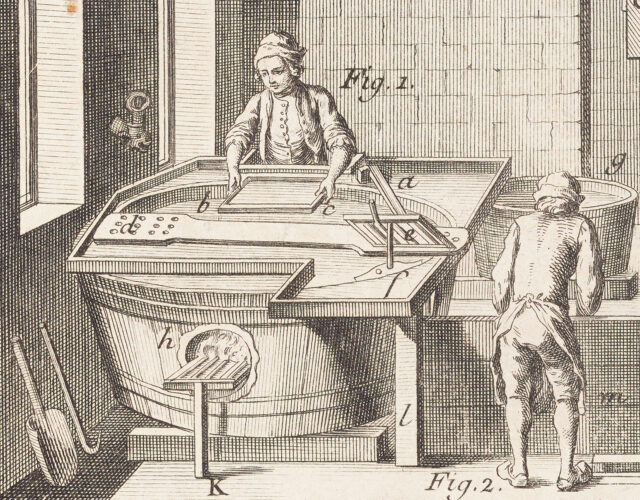The dispersal of Isaac Newton’s chaotic manuscripts at a Sotheby’s sale in 1936 was the final chapter in a centuries-long disordering of the scientist’s wide-ranging collection of notes. In the wake of the sale, little by little, order has been restored and, arguably, imposed.
What were described at his death as “reams of loose and foul papers” have over the years been organized by their custodians. For instance, some of the first collectors, including economist John Maynard Keynes, tried to regather the manuscripts by focusing on theme (alchemical manuscripts in Keynes’s case). More recently, large-scale digital humanities projects have been reuniting the manuscripts—if only in virtual form—and organizing them by subject and other criteria.
The oldest and largest of these digital ventures is the Newton Project, now based at Oxford University. Created in 1998, the project has transcribed more than four million words of Newton’s writings, primarily those in physics, mathematics, and theology. Working in tandem with the Newton Project is the Chymistry of Isaac Newton at Indiana University, an undertaking to produce a similarly comprehensive, web-based edition of Newton’s papers but limited in scope to alchemical manuscripts. I am very familiar with the latter project; in 2003 I was hired as the first full-time employee, and I now serve as senior consulting editor. There are about a million words in the alchemical manuscripts, which the Chymistry of Isaac Newton is steadily putting online.
The mass of digital surrogates and transcriptions assembled by these projects allow scholars to ask some previously unanswerable questions: Is there any way to make chronological sense of these mostly undated manuscripts? Is there any way we can establish—nearly 300 years after their creation—which document came before which or even what year some of them were written in? The answer is, surprisingly, yes. There are tools and techniques based on content, orthography, and physical characteristics that we can wield like detectives as we try to put Newton’s notes in order.
The first among these techniques—the analysis of the manuscripts’ contents—depends on the skills of the historian.
When the Newton manuscripts owned by chemist and bibliophile Roy Neville first came to the Science History Institute’s Othmer Library in 2004, one of the first historians to examine the manuscripts since the Sotheby’s sale in 1936 was Lawrence Principe, who recognized that the notes detailed two of three “periods,” or steps, in the making of the philosophers’ stone. Principe knew these steps had originally been described by Robert Boyle and had become the topic of an exchange of letters between Newton and John Locke (yes, that John Locke) after Boyle’s death. From the correspondence and a corresponding entry in Locke’s diary, Principe was able to pinpoint the date of the manuscript to May 1692.
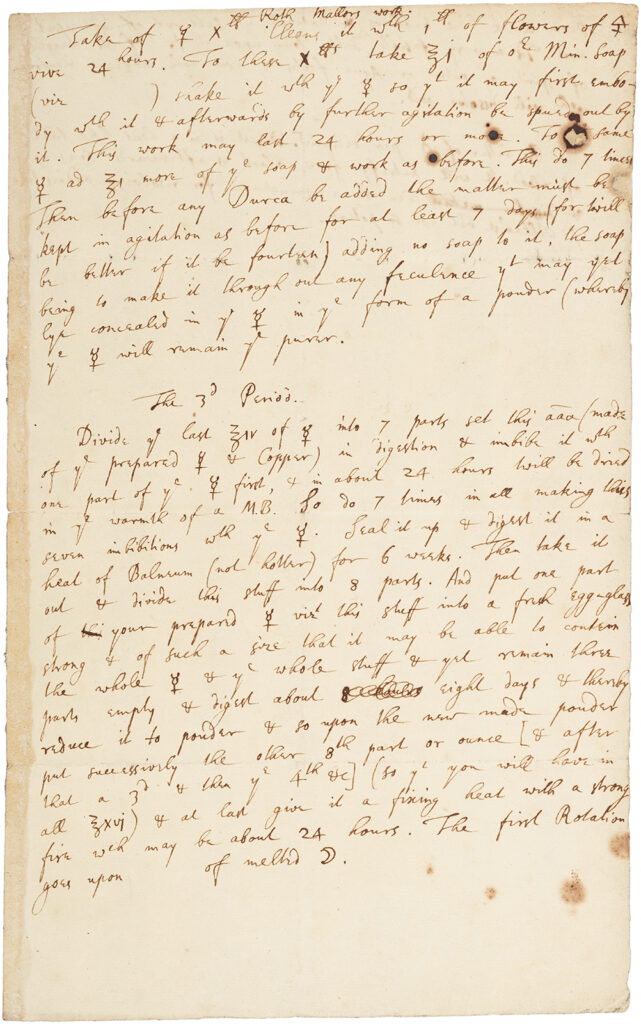
The content of the manuscripts can help date them even in the absence of corroborating dated material, as with the Newton–Locke correspondence. The preponderance of Newton’s alchemical papers are reading notes. Newton spent years trying to fight his way through the thicket of metaphors and Decknamen (code names) used by alchemists to misdirect all but the most worthy from understanding their secrets. One of the ways he did this was by cross-referencing terminology used by different authors in the hope of triangulating to the truth. He kept mostly clear records of the passages he copied out from alchemical authors, noting the work and page number where he found the material.
In some cases, we can use those references to provide a terminus post quem, a “limit after which” something must have been written. For example, in a manuscript known as Keynes Ms. 53, now at King’s College Library in Cambridge, Newton cites “Le Triomphe, p. 42, 43, 44.” This citation refers to a French translation of the anonymous German Uralter Ritter-Krieg, first published in Amsterdam by Henri Wetstein in 1689, indicating that the manuscript could not have been written before that time.
But dating manuscripts in this way is not always so straightforward. Sometimes we can distinguish which edition of a book Newton is referring to by matching his page reference to the material in the book, but this works only if the type was reset between editions and the contents end up falling on different pages, in which case Newton’s page references act as a kind of fingerprint that distinguishes one from the other. But often a reprint was simply a line-for-line copy of an earlier edition. There’s a good reason for this—setting and justifying type was hard, time-consuming work. It was much easier to copy the work of the original compositor than to start over again.
The vagaries of the early printing industry can make it even more difficult to use page references as dating devices because it was also common for publishers to reissue previously printed sheets in a new “edition.” Books were commonly stored as unbound stacks of printed sheets. If a book did not sell out, it was child’s play for a printer to throw away the old, stale title page from years past, print a new title page with the current year, and—presto!—a new “edition.” I use quotes around “edition” because bibliographers call this kind of shenanigan a reissue; a new edition arises only if the type has been physically reset. (It doesn’t matter if it’s a line-for-line copy; as long as it’s been reset, it’s called a new edition.)
This repurposing and reissuing can become downright Byzantine. Consider one of Newton’s sources, Trois traitez de la philosophie naturelle. It was originally published in Paris in 1612 in a 103-page edition by Guillaume Marette. Almost 50 years later another publisher reissued the book in a clandestine 98-page edition. Confusingly, much—but not all—of the print run falsely bore the date 1612, named the publishers as “Widow of M. Guillemot and S. Thiboust,” and included a colophon (a statement of printing information found on the final page of a book) also dated 1612.
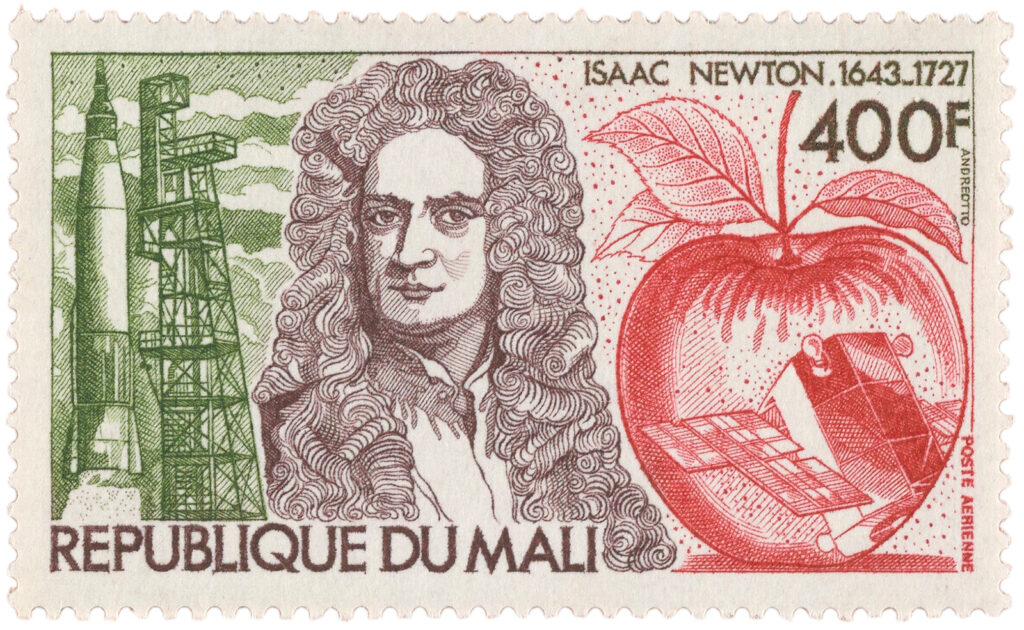
The widow of M. Guillemot and S. Thiboust were indeed publishers who had been active in 1612, though the pirate publisher possessed neither of their printer’s marks to complete the forgery. We can tell this second “1612 edition” was actually printed in 1659 because other copies have the identical setting of type but bear the date 1659 and are attributed to two different Parisian publishers, Thomas Jolly and Jacques d’Allin. (Whether either of these men was the actual 1659 publisher is an open question.) The colophon was also updated to 1659 in the Jolly and d’Allin copies, but the deceit was not perfectly executed: at least one copy ended up with the 1612 colophon.
This book’s story gets even more convoluted. The unsold pirate copies were obtained in 1682. We don’t know which imprints were bought because the new publisher, well-known alchemical publisher Laurent d’Houry, discarded the title pages and reissued the sheets with a new title (Philosophie naturelle de trois anciens philosophes), a new preface, and a new translation of English alchemist George Ripley’s Traité du Mercure, which d’Houry appended to the end as pages 99 to 106. He did not, however, dispose of the 1612 or 1659 colophons, which sit awkwardly on page 98 after the word FIN (“the end”), in the midst, not at the end, of the printed text.
While the method of dating Newton’s manuscripts by the sources he references is sound, 17th-century publishers can throw us a curveball from time to time. For this reason, it is helpful to have a bibliographical expert on the team, which is the role I play for the Chymistry of Isaac Newton to undertake this kind of analysis.
In the absence of textual evidence, the physical manuscripts themselves can help suggest a composition date. One promising technique relies on watermarks.
All paper was handmade until the early 19th century. From the 13th century onward, most paper had watermarks, which acted as trademarks for the mill or region of mills producing the paper. Scholars have long used watermarks to roughly date paper. But the same watermark design might be used for decades and decades on end, so on their own they are only so useful for dating.
Fortunately, it is exceedingly difficult to create exact duplicates of watermarks over extended periods of time. Scholars have learned to spot evidence of these changes in the paper itself, and this knowledge often allows them to date a sheet’s manufacture quite accurately. To understand how, it helps to know how paper was made.
The process began with a papermaker passing a slurry of fibers through a rectangular sieve about the size of a cafeteria tray. The sieve was constructed of a wooden frame with a series of regularly spaced thin, wooden ribs running parallel to the shorter side of the mould. Attached to the top of each of these ribs was a tiny brass chain, and running through the links of the chains, parallel to the longer side of the mould, were scores of thin brass wires. When the slurry passed through the wires, less material was deposited where the water was obstructed by the chains, creating chain lines. If you hold the paper up to the light, you can see a series of parallel lines about an inch or two apart that are lighter than the rest of the paper. Papermakers as far back as the 13th century figured out they could manipulate this effect to produce decorations by sewing a design with brass thread onto the wires. Where the sewn pattern obstructed the flow of the slurry, the paper would be thinner and pass more light, creating a watermark.
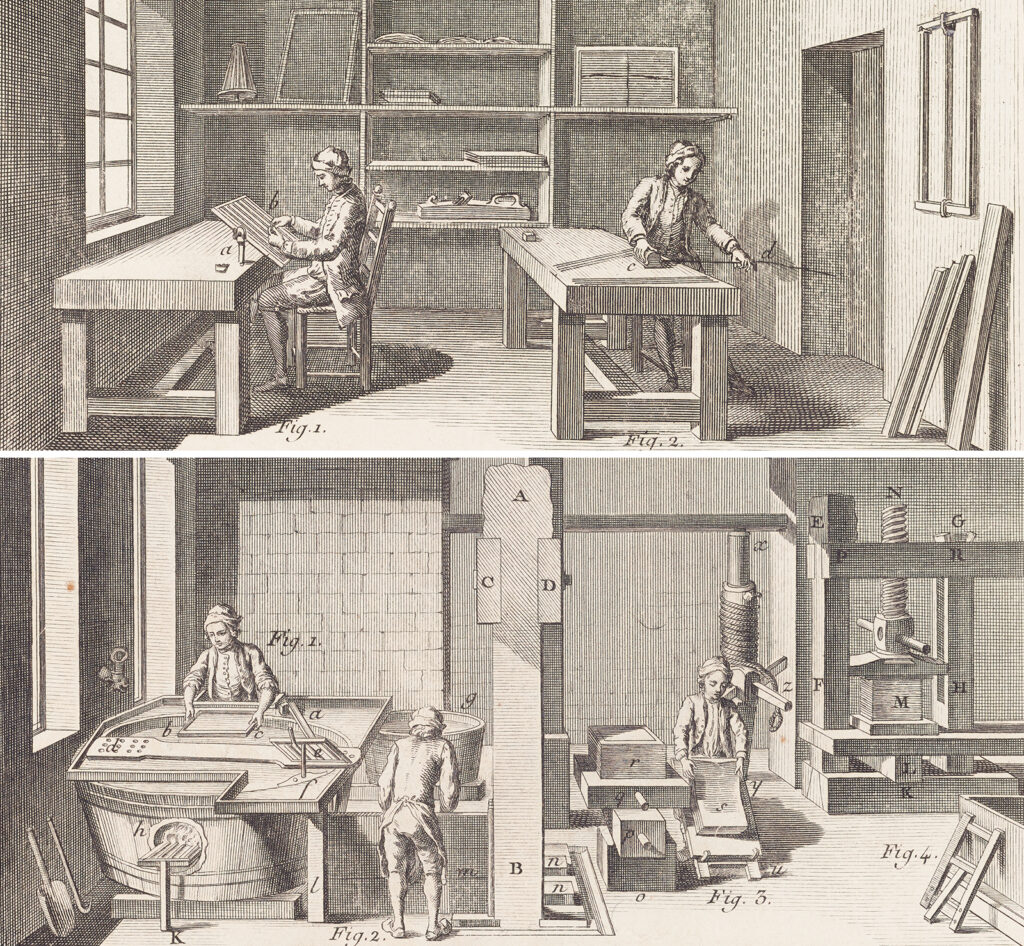
Papermakers worked hard, producing hundreds of sheets of paper a day, and their moulds wore out after a year or so of use. The design sewn onto the new mould would not be identical to the one in the mould it was replacing. And this provides the potential for dating documents rather precisely based on their watermarks.
To speed their workflow, a team of papermakers used two moulds that were twins, so in principle half the sheets in a ream of paper would have one watermark and the other half would have its twin.
Paper was expensive, but we assume Newton bought enough to hold him for a few months or even up to a few years. Each clean sheet of paper he took off the stack should then have one of two watermarks. If we can find those watermarks in dated manuscripts, like letters or legal documents, they should provide the time frame for other undated manuscripts with the same watermarks.
This is the approach being used in a new research project, which brings together institutions that have undated alchemical manuscripts—for example, the Huntington Library and Science History Institute—with an institution that has dated Newton papers, such as the U.K. National Archives. By virtue of Newton’s appointment as warden and then master of the Royal Mint, there is a large body of dated correspondence and legal documents at the National Archives whose watermarks we hope to match to alchemical manuscripts.
This is easier said than done. Watermarks are tricky to image, especially on pages that have writing on them. (That is to say, all the interesting ones.)
For many years the gold standard in imaging watermarks was beta radiography, which worked by sandwiching a watermarked page between a piece of photographic paper and a thin sheet doped with a radioactive compound. After the sheets- were left clamped together for some hours, the beta particles released in radioactive decay would expose the film, more in areas where the paper was thinner and less where it was thicker, exactly the sort of effect that makes a watermark easier to see. Unfortunately, the process is expensive and time-consuming, making it impractical to implement on the scale necessary for this project. We need an easier method.
The National Archives has had some success manipulating ordinary reflected-light and backlit images of the same manuscript. Digitally subtracting one image from the other produces an enhanced picture of the underlying watermark. This method is fast and easy but requires reimaging of all the materials to perfectly align the reflected-light and backlit images. We are also investigating using infrared transmissive photography on the premise that the type of ink used by Newton is transparent under infrared light. A recent trial with some of the Huntington Library’s manuscripts was extremely promising, producing images similar to the reflected-light/backlit method but with a single exposure.
But we really want to be able to include far more Newton manuscripts than we can afford to reimage. And this is where machine learning comes in. Watermarks can be seen in photographs, but they are very difficult to pick out, especially amid the confusion of the writing on the page. Perhaps a neural network, trained on a data set of watermark images already compiled by American institutions and the National Archives, could extract and identify watermarks from a plain, reflected-light image? That would allow us to incorporate the watermarks from hundreds of already-imaged Newton manuscripts, such as those at Cambridge University Library, into the project database.
And there’s more potential for machine learning. Watermark investigators use a few tricks to characterize the small variations in the moulds used by a papermaker over time, for instance, by recording precisely where a design intersects the chain lines or noting how far from the chain lines the furthest left and right extent of the design are. But for the most part, matching two identical pieces of paper requires careful examination of each and every watermark, and there are liable to be dozens or scores of different watermarks in the Newton papers. What if we could train artificial intelligence to match identical watermarks? Such a program could be used to classify the hundreds or thousands of watermarks used in handmade paper across Europe and across the centuries.
Watermarks aren’t the end of the tools at our disposal to make order out of Newton’s manuscripts. For many years scholars have tried to date Newton manuscripts based on changes in his handwriting over his lifetime, but this method is now considered unreliable. However, there is still some value in this approach.
Historian William Newman noticed that the way Newton makes certain symbols seems to change over time. For instance, the symbol for the planet Saturn and the metal lead (♄) looks like an h with a cross through the ascender, as in a t. In early manuscripts, Newton doesn’t bother crossing the ascender; in late manuscripts he always crosses the ascenders. So if all the lead symbols are uncrossed, a manuscript is generally early; if they’re all crossed, it’s late. If the symbol usage is mixed, the manuscript is probably somewhere in-between.
Similarly, in earlier manuscripts Newton consistently misspells the Latin word separare as “seperare,” but in later manuscripts he corrects this error. His English spelling is probably too inconsistent—sometimes comically so—to attempt the same.
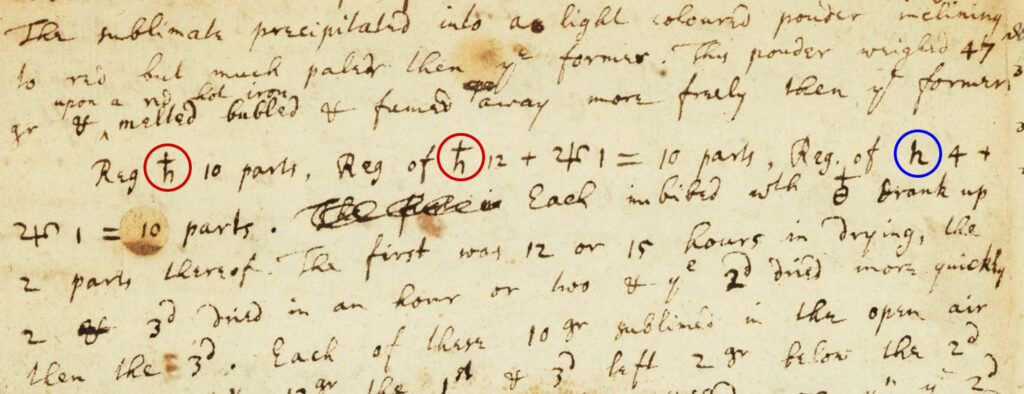
A potentially more scientific approach involves analyzing the ink Newton used. The first alchemical recipe I encountered as a transcriber for the Chymistry of Isaac Newton project was near the beginning of a document known as Cambridge University Additional Manuscripts 3975. It is titled “To make excellent Ink.” At the conclusion of the recipe is this charming note: “With this Ink new made I wrote this.” Newton, like many of his chemically adept contemporaries, made his own iron gall ink. Could differences in the batches of ink help determine the sequence of their composition? (Chymistry of Isaac Newton project manager Wallace Hooper used the color of ink in Galileo’s manuscripts to try to figure out their sequence of composition. The Chymistry of Isaac Newton is now trying something much more sophisticated.)
Newton made his ink from oak galls, gum arabic, copperas (impure iron sulfate), and beer. Needless to say, none of these were laboratory-grade reagents, and we would expect the chemical composition of the ink to vary considerably from batch to batch. So, is there a nondestructive way to distinguish different batches of Newton’s ink? This kind of information would be helpful in situations where Newton may have revised his notes months or years after their initial composition.
The answer is, we hope, yes, and the method of choice is X-ray fluorescence spectroscopy (XRF). In XRF a sample is bombarded by X-rays. When an X-ray dislodges an electron in one of the lower energy states in an atom, an electron in a higher energy state will repopulate the lower level, but to do so the electron must discard some energy in the form of a photon. The X-rays emitted when changing from one energy level to another are characteristic for each element. By collecting a range of X-ray energies coming back from the sample, the XRF spectrometer can determine both the elements in a sample and their proportions. By plotting characteristic ratios of iron, copper, and zinc in Newton’s ink, we hope to be able to identify and date different batches and so reveal the relationship between manuscripts and, consequently, when they were written.
In Query 31 of his Opticks, Newton famously asks, “Have not the small Particles of Bodies certain Powers, Virtues or Forces, by which they act at a distance, not only upon the Rays of Light for reflecting them but also upon one another for producing a great part of the Phaenomena of Nature?” He was groping toward the idea that there were tiny constituents of matter that attracted or repelled one another, thereby producing chemical effects.
It is charming to think now that those tiny atoms, either the chemical impurities in the ink with which he wrote those words or in the semiconductors in the imaging and computer systems used to analyze them, are providing the means to make sense of the writings of the man who conceived them.
Funding for a portion of this research is provided by NSF award 2021012, “A Multidimensional Reconstruction of the Order of Composition of Historical Manuscripts from Textual and Material Evidence.” The research on watermarks is a collaborative project jointly funded by NEH grant HC-278119-21 and an Arts and Humanities Research Council (U.K.) grant, “Digital approaches to the capture and analysis of watermarks using the manuscripts of Isaac Newton as a test case,” whose participating institutions are Indiana University, the Huntington Library, the Science History Institute, Cambridge University, and the National Archives of the United Kingdom.

